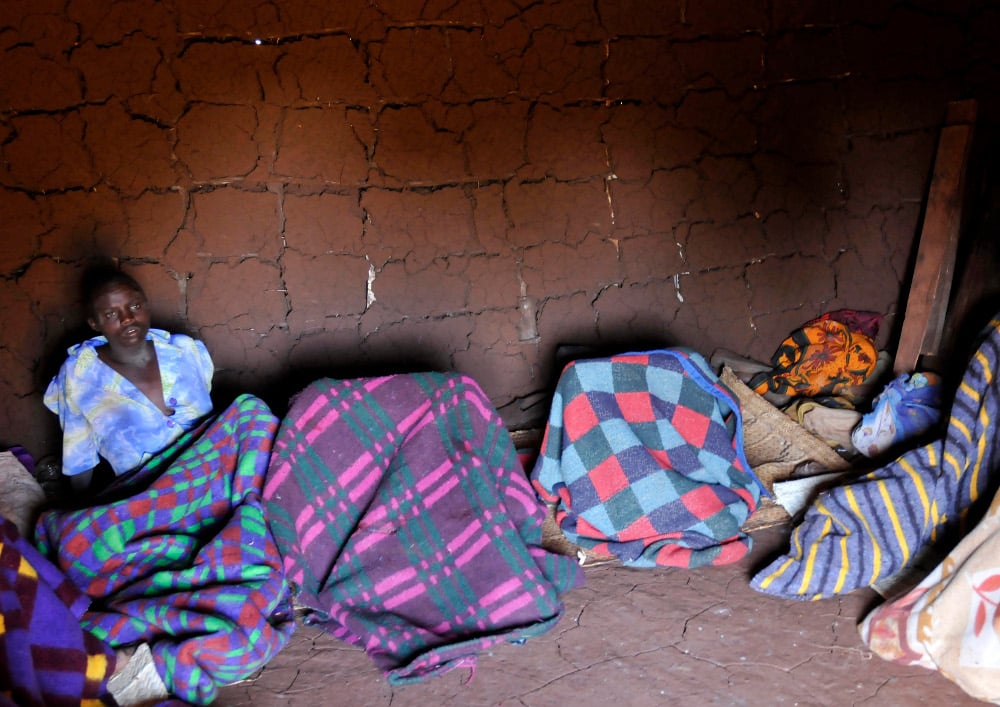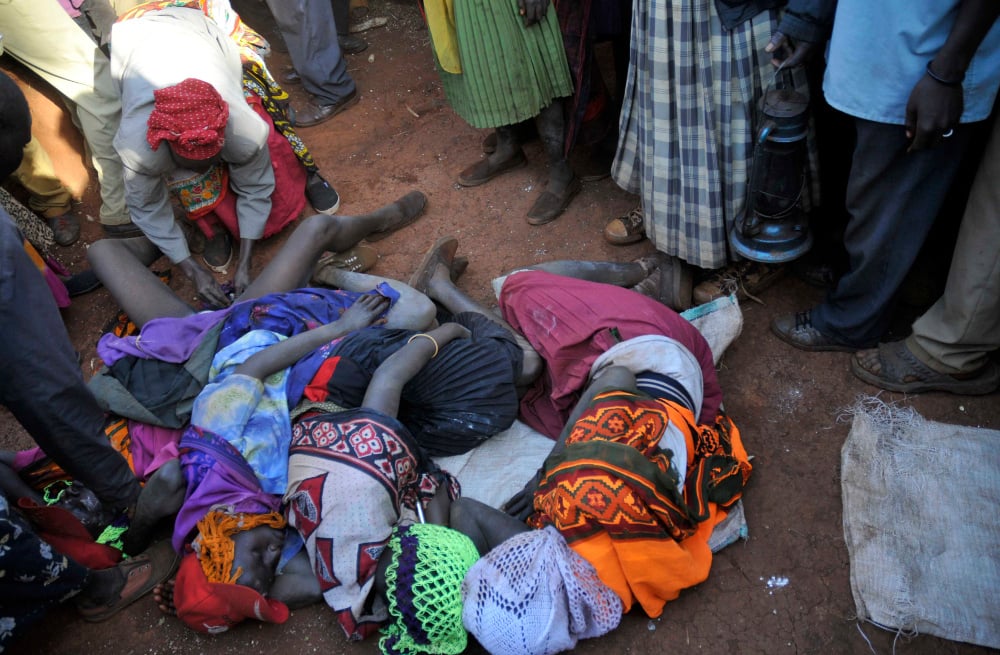Razor blades are often used to perform FGM. Photo by James Akena Reuters
“On my wedding night, it felt like having a flame on an open wound,†the woman with eyes the colour of honey tells us, enraged. “He enjoyed it but I experienced the same pain I felt when I was a little girl and they cut open my genitalia with a razor and then sewed it closed with thorns: I couldn’t move for ten days because my legs were tied together and I couldn’t even go to the bathroom. My memory of it is still bitter and intact.â€
On the outskirt of Daami, the undergrowth overflows with garbage and the round huts are covered in rags. Nuura Mahamud Muse, 35 years old and the mother of six girls, sits on a filthy mat and remembers the torture ritual that her country practices to sanction female virginity. “I won’t let my daughters to be touched, though,†she asserts over the noontime call to worship by the muezzins. “I don’t want them to suffer like I do every menstrual cycle, during sexual intercourse, when giving birth. I don’t care if the neighbours badmouth me.â€
Daami is situated beyond the Waaheen River shoal in Hargeisa, the windy capital of Somaliland, a republic you won’t find easily on a map. North of the Horn of Africa, in 1991 the former British Somalia declared independence from the former Italian Somalia in order to disengage from the conflict that continues today in Mogadishu. But it paid for its freedom by being virtually non-existent.
The international community does not recognise this State with its 4 million inhabitants which are divided into three family clans that, aside from the war, have everything else in common with Somalia: language, poverty, and a patriarchal culture that blends Islam with ancient traditions. These include gudniinka fircooniga, the “pharaonic†female genital mutilation or infibulation, a seal of chastity inflicted on girls from the age of five and beyond: all the external genitalia is removed, then the vagina is sewn together using needle and thread or thorns from the wild-growing qodax plant, until the tissues from the wound bond leaving a small hole for urine and menstrual blood, to be cut open on the wedding night.

A young girl rests after having undergone female genital mutilation. (James Akena, Reuters)
Vaginal amputation across the globe
All over the world, over 125 million women are branded by blood and condemned to infections, chronic cysts, excruciating menstrual pain, distressing sexual intercourse, complications during childbirth, all in the name of presumed ideals of morality and respectability. Of the 27 African countries where various types of vaginal amputation are in use, Somalia and Somaliland practice the most extreme type and hold first place with the highest prevalence rate: “98% of our women are infibulated and sewn up again after the birth of each child, resulting in 6 to 13 stitchings throughout their lives,†points out Sadia Abdi, the young ActionAid NGO Country Director in Somaliland, who studied in England and later came back to the dirt roads and hectic marketplaces of her native Hargeisa to resume the battle she had begun when she was only 14 years old.
“I saved my younger sister from infibulation,†she says. “My mother kept telling me: ‘You can’t fight against it, it’s part of your identity and womanhood, an Islamic precept’.†When an Imam assured me that there is no trace of this practice in the Koran, I told my mother and she gave in, but placed the honour of the family upon my shoulders. I felt so relieved when my sister found a husband who wanted to marry her for love even though she was “different†from the othersâ€.
Act of violence
Sadia doesn’t talk about herself. She emphasises the fact that infibulation is “an extreme act of violence against women, a concept of male domination that saturates our society and perpetuates gender inequality.†But listening to her, you notice that her subversive tenacity flows from deep within. “My daughter is five years old and she will remain intact,†she states. “She won’t miss a day of school because her menstrual blood burns with pain; she’ll be able to play and run free from the fear that the stitches could rip open; she will never damn the fact she was born female.â€
In order to understand just how overwhelming social pressure is, Sadia remembers the tragic story of her cousin, who committed suicide because she didn’t undergo infibulation and so at school they called her kintirleeyi: an insult for trampy women with a clitoris. Thanks to Sadia Abdi’s placid stubbornness and ActionAid’s commitment, there are currently 53 women’s coalitions in Somaliland challenging the greatest taboo. Hawa Muhumed Madar, 65, leader of the women in Agamsaha village, admits to the guilt she feels for having had her daughter infibulated: “Back then, tradition was not put under discussion, but now we are strong, united, and we won’t take it anymore.â€

Women lie on the ground after their female genital mutilation procedure. (James Akena, Reuters)
Abolition movement
The same revolutionary stance is taken by Maryan and Nymco who used to be professional circumcisers until recently, earning 10-15 dollars per girl: “We’ve been taught that it’s against Islamic law,†they state “so now we teach this to our communities.†The iconic spokesperson for the battle for women’s liberation and the abolition of female genital mutilation is a glowing, energetic 78-year-old lady: Edna Adan Ismail, midwife, former Foreign Minister and UN delegate. In the 1970s, she was the very first woman in the Horn of Africa who dared publicly crying out against the ferocity of the pharaonic ritual. “It means death for mother and child,†she bellows today in the hospital she had built in Hargeisa with her own funds, recalling that the maternal-infant mortality rate in Somaliland is over four times higher than the average of developing countries.
“Only seven hospitals in Somaliland carry out caesarean sections: in the other health facilities, if the artificial barrier hasn’t already suffocated the child, the stitching is ripped open with scissors which can lead to the fistula, the worst death sentence possible. Why do you think I’ve been fighting against infibulation for over forty years? Because it kills.—We have created a national movement, involving husbands and religious leaders, but we haven’t become a critical mass yet,†sighs Aamina Milgo, Chairperson of the Network against FGM in Somaliland (NAFIS). In a country where 85% of the women are illiterate (with respect to 64% of the men), her primary target is ignorance: “There are people who believe the clitoris will grow disproportionately if it’s not cut, and those who accuse you Westerners of inciting us against our own culture. In the past, they instilled us with the belief that suffering through the torture was something to be proud of: to this day, for many women, not being sewn is a stigma.â€
Religious obligation
Even though the codes of the clans, here, come before the laws of the State and even before the Islamic Sharia, the women’s coalitions clamour for the abolition and illegality of female mutilation, as has already taken place in 21 African countries that are affected by this problem. “A draft of a proposal of law has been in the Parliament since 2011,†Sadia Abdi states, “but the Ministry of Religious Affairs, that examines and evaluates all decisions, has yet to take a stand.â€
An eminent Imam, Yousuf Abdi Hoore, explains us which is the critical point: while infibulation “is cruel, and extraneous to Islam†he says, a mild type of female circumcision appears in a prophetic tradition (hadith) and so, according to the Islamic school followed in Somaliland, it’s recognized as an obligation. “It’s called Sunnah: a very small incision to the clitoris thereby bestowing beauty and purity.†But women reject any sort of compromise: “We demand zero tolerance for all types of genital mutilation,†declares Sadia Abdi who, law or no law, wants to first and foremost change the way people think: “By creating awareness and knowledge in the villages, and getting mothers, fathers, and religious leaders involved, my hope is that the next generation will be free from the horrors of infibulation.â€
While the usual afternoon wind blows, she takes us to view her Hargeisa from high ground: a flat geometry disturbed by the two twin hills Naasa Hablood, that means “Girl’s Breasts†in Somali language. As if femininity, in this non-place, was already blooming on the horizon.
This article was produced by UNCUT project on female genital mutilations with the support of the “Innovation in Development Reporting Grant Program†http://journalismgrants.org/ of the European Journalism Centre (EJC), funded by the Bill & Melinda Gates Foundation, and carried out in partnership with ActionAid https://www.actionaid.it/ NGO and the cultural association Zona http://www.zona.org/en/.
